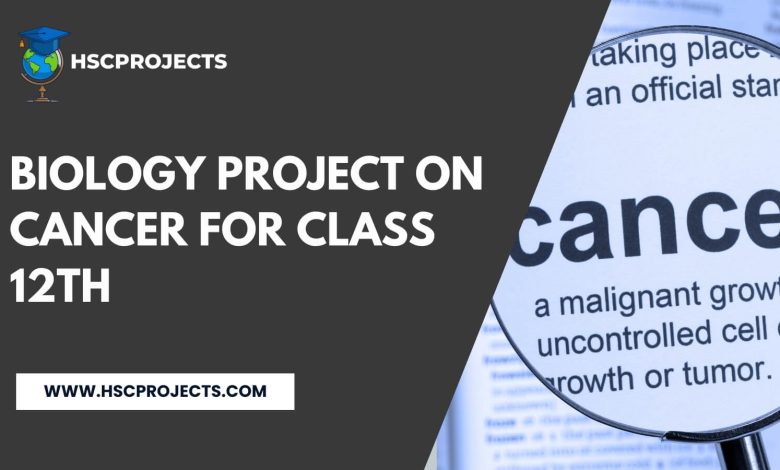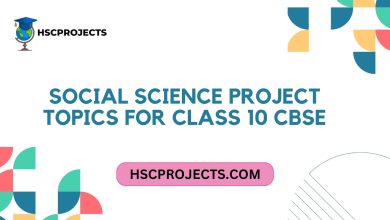
Biology Project On Cancer For Class 12th
Acknowledgment
I want to express my heartfelt appreciation to my biology mentor, [Teacher’s Name]. Their unwavering support and expert guidance have been invaluable in shaping this project and deepening my understanding of the intricate world of cancer.
Introduction on Cancer
Cancer isn’t just another health challenge; it’s a formidable adversary. It’s not a solo act but a group of conditions characterized by the wild proliferation of abnormal cells within the human body. This project sets out to illuminate the intricacies of cancer, delving into its origins, traits, causes, and repercussions.
Human Cancer Cell
At the core of cancer’s mystery lies the transformation of regular human cells into rogue cancer cells. This transformation is spurred by genetic mutations that disrupt a cell’s rulebook, causing it to shrug off growth controls and elude the body’s natural defenses.

Cancer Cells vs. Normal Cells
Cancer cells couldn’t be more different from their law-abiding counterparts. While normal cells adhere to a well-choreographed routine of growth, division, and programmed self-destruction (apoptosis), cancer cells throw caution to the wind. They engage in unbridled multiplication, evade the vigilant scrutiny of the immune system, and have the audacity to embark on metastatic journeys, infiltrating distant corners of the body through the bloodstream or lymphatic system.

Causes of Cancer
The genesis of cancer is a multifaceted saga shaped by an array of factors:
Genetic Mutations: It all starts with mischievous mutations in a cell’s DNA, paving the way for unchecked growth. These mutations can either be handed down through generations or acquired due to encounters with environmental factors.
Carcinogens: A rendezvous with carcinogens, like the treacherous tobacco smoke, relentless ultraviolet (UV) radiation, and certain chemical troublemakers, can inflict DNA damage and boost the cancer risk.
Viral Invasions: Some stealthy viruses, such as the human papillomavirus (HPV) and the cunning hepatitis B and C, play their part in the creation of specific cancers.
Lifestyle Choices: Dietary indiscretions, a sedentary existence, and excessive indulgence in spirits can all elevate the cancer risk.
Signs and Symptoms
Detecting the early warning signals of cancer is pivotal for timely diagnosis and intervention. These indicators may manifest as:
Lethargy: Lingering and unexplained weariness.
Puzzling Weight Loss: Shedding pounds without a discernible cause.
Aches and Pains: Persistent discomfort that defies conventional remedies.
Skin Stories: Shifts in the appearance of moles or skin lesions, like a plot twist in a thriller.
Bumps and Bulges: Peculiar protrusions or swellings that make an unscheduled appearance.
Gut Feelings: Unusual shifts in bowel or bladder habits that raise questions.
Cancer Cell Division
Cancer cell division is a realm of unchecked and lightning-fast proliferation. Several critical distinctions set cancer cell division apart from the norm:
Unbridled Growth: Cancer cells conveniently ignore the body’s usual division signals, leading to an unruly and excessive multiplication.
Apoptosis Amnesia: Apoptosis, the scripted cell self-destruction, becomes a forgotten concept for cancer cells. They dodge this crucial process, allowing their persistence and accumulation.
Genetic Plot Twists: Genetic mutations within cancer cells throw the cell cycle into disarray, resulting in an overproduction of offspring.
Metastasis Mayhem: Cancer cells embark on a rogue journey. They infiltrate nearby tissues and embark on a globetrotting adventure via metastasis, escaping from the primary tumor, hitching rides in the bloodstream or lymphatic system, and establishing secondary tumors.
Understanding this aberrant cell division in cancer is a linchpin for crafting targeted therapies aimed at controlling or halting this chaotic process.
Types of Cancer and Their Symptoms
Cancer comprises a diverse medley of diseases, each with its own set of symptoms and idiosyncrasies. Here’s a glimpse of some common types and their telltale signs:
Breast Cancer: Symptoms may present as a mysterious lump in the breast, nipple metamorphoses, or breast discomfort.
Lung Cancer: The usual suspects include an enduring cough, chest discomfort, and breathlessness.
Prostate Cancer: Urinary dilemmas, frequent restroom rendezvous, and blood in the urine can all hint at its presence.
Leukemia: Fatigue, easy bruising, bleeding, and a penchant for infections can all be part of the leukemia storyline.
Skin Cancer: Watch out for changes in moles, the sudden arrival of new growths, or stubborn sores that refuse to fade.
These are just a few facets of the kaleidoscope, and cancer’s symptoms can waltz across a broad spectrum depending on the type and stage of the malady.
Location of Cancer
Cancer can set up shop virtually anywhere in the body. The location wields a considerable influence over both the symptoms and treatment options:
Breast: The battleground is breast tissue, frequently impacting women but sparing no thought for the gender barrier.
Lungs: The lung tissue is its canvas, often painting respiratory symptoms.
Colon and Rectum: Colorectal cancer prefers the stage of the colon or rectum, altering bowel habits along its path.
Skin: Sun-exposed areas are the breeding grounds for skin cancer, manifesting as peculiar skin growths.
Blood: Blood cancers, such as leukemia, venture into the blood-forming tissues, sowing fatigue, infections, and bleeding in their wake.
Comprehending the origins of cancer is pivotal for precise diagnosis and tailored treatment.
Prevention of Cancer
Preventing cancer unfurls a proactive tapestry of risk reduction:
Healthy Living: The mantra involves a balanced diet teeming with fruits and veggies, regular physical activity, and shunning tobacco and excessive libations.
Vaccination Vigilance: Some vaccines, like the HPV shield, offer protection against cancer-conspiring viruses.
Screening Safeguards: Regular cancer screenings and health check-ups serve as sentinels, detecting cancer at an early, conquerable stage.
Cancer Treatment
Cancer treatment is a multi-pronged assault strategy contingent on cancer type and stage. The toolbox includes:
Surgery: The carving out of cancerous tissue or tumors through surgical maneuvers.
Chemotherapy: Unleashing drugs to obliterate cancer cells or halt their rampage.
Radiation Therapy: Employing high-energy rays or particles to pinpoint and obliterate cancer cells.
Immunotherapy: Boosting the immune system’s artillery for a cancer showdown.
Targeted Therapy: Medications aimed squarely at molecules in the cancer growth saga.
Hormone Therapy: Blocking hormones that fuel specific cancer types.
Treatment regimens often don bespoke attire tailored to individual cases, sometimes marrying a medley of strategies.
Conclusion
Cancer persists as a formidable adversary on the global health stage, impacting countless lives annually. Unpacking the intricacies of cancer cell division, recognizing its various guises and symptoms, identifying its hideaways, and championing cancer prevention constitute pivotal steps in managing this formidable foe.
Advancements in research and treatment cast a hopeful glimmer on the horizon, promising improved outcomes and a brighter future in the battle against cancer. Early detection, effective intervention, and unwavering awareness can script a significant narrative shift for those ensnared by the clutches of cancer.
References:
- American Cancer Society. (2021). What Is Cancer? https://www.cancer.org/cancer/cervical-cancer/about/what-is-cervical-cancer.html
- National Cancer Institute. (2021). Cancer Types. https://www.cancer.gov/types
- World Health Organization. (2021). Cancer. https://www.who.int/news-room/fact-sheets/detail/cancer
- American Cancer Society. (2021). Signs and Symptoms of Cancer. https://www.cancer.org/cancer/cervical-cancer/detection-diagnosis-staging/signs-symptoms.html
- American Cancer Society. (2021). Cancer Prevention & Early Detection Facts & Figures 2021-2022. https://www.cancer.org/research/cancer-facts-statistics/cancer-prevention-early-detection-facts-figures.html
- National Cancer Institute. (2021). Cancer Treatment. https://www.cancer.gov/about-cancer/treatment
- American Cancer Society. (2021). Immunotherapy for Cancer. https://www.cancer.org/cancer/cervical-cancer/treating/immunotherapy.html
- American Cancer Society. (2021). Targeted Therapy for Cancer. https://www.cancer.org/cancer/cervical-cancer/treating/targeted-therapy.html
Certificate of Completion
[Student’s Name][Class/Grade Level]This is to certify that I, [Student’s Name], a [Class/Grade Level] student, have successfully completed the project on “Cancer For Class 12th.” The project explores the fundamental principles and key aspects of the chosen topic, providing a comprehensive understanding of its significance and implications.
In this project, I delved into in-depth research and analysis, investigating various facets and relevant theories related to the chosen topic. I demonstrated dedication, diligence, and a high level of sincerity throughout the project’s completion.
Key Achievements:
Thoroughly researched and analyzed Biology Project On Cancer For Class 12th.
Examined the historical background and evolution of the subject matter.
Explored the contributions of notable figures in the field.
Investigated the key theories and principles associated with the topic.
Discussed practical applications and real-world implications.
Considered critical viewpoints and alternative theories, fostering a well-rounded understanding.
This project has significantly enhanced my knowledge and critical thinking skills in the chosen field of study. It reflects my commitment to academic excellence and the pursuit of knowledge.
Date: [Date of Completion]Signature: [Your Signature] [School/Institution Name][Teacher’s/Examiner’s Name and Signature]
In order to download the PDF, You must follow on Youtube. Once done, Click on Submit
Follow On YoutubeSubscribed? Click on Confirm
Download Biology Project On Cancer For Class 12th PDF






